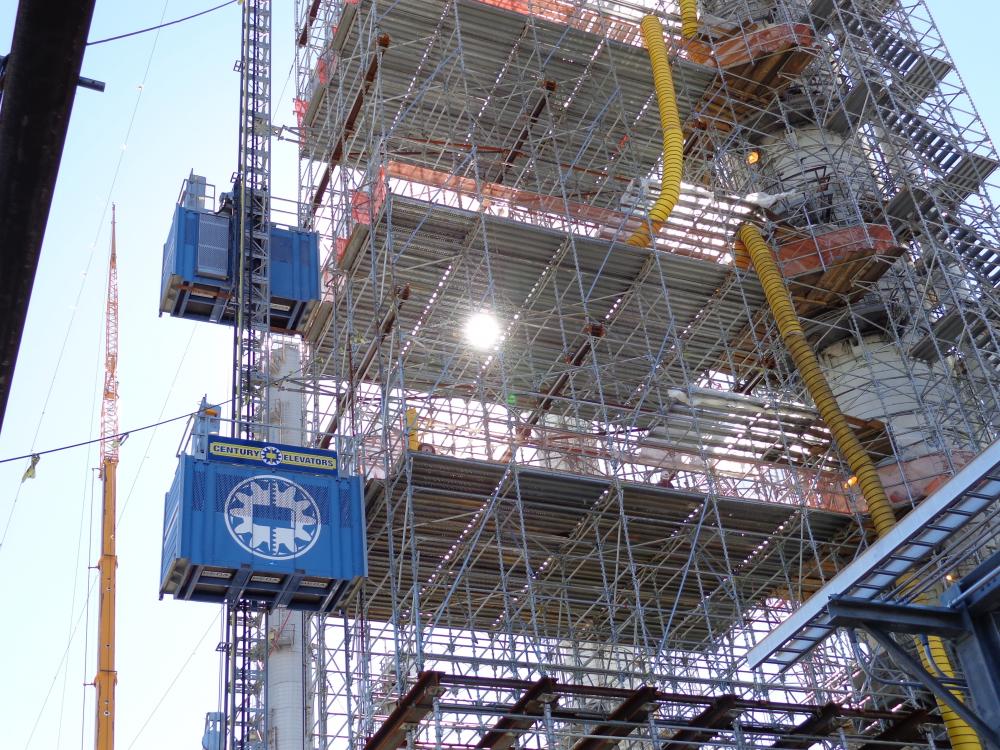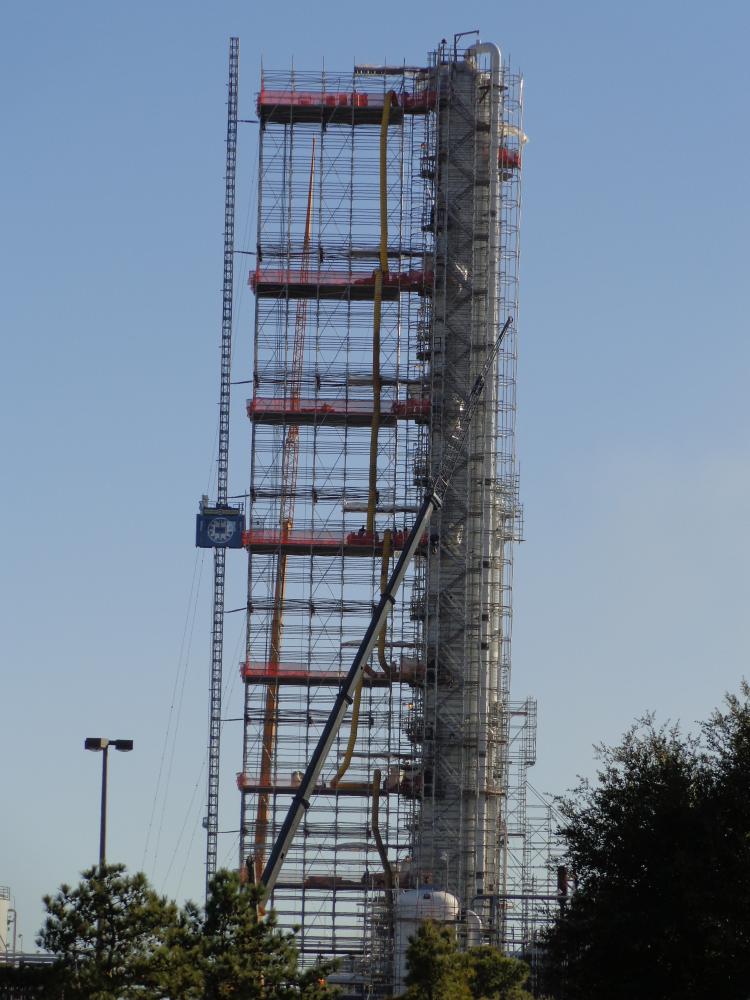

Sulphur, La., is home to Westlake Chemical Corporation’s largest and most productive polyethylene plant. In September 2012, Westlake announced plans to perform routine maintenance on the plant’s C2 splitter—a tower structure that splits chemicals— as well as expand its Petro 2 ethylene unit. The expansion increases the ethane-based ethylene capacity by approximately 230 million to 240 million lbs. annually in support of the company’s ethylene integration strategy. The unit was expected to be down approximately 50 to 60 days for the work to be completed.
Maintenance to the C2 splitter was performed to increase equipment service life and reduce the number of costly equipment replacements. (Other benefits of routine maintenance include a decrease in emissions and leaks as a result of better performance, and greater operating efficiencies resulting from process upgrades.)
Gallop Tower Field Services oversaw the logistics on site during the massive turnaround that included creating the safest possible work environment for more than 2,500 workers, while maintaining an efficient working schedule. The nature and design of the C2 splitter made achieving the goal challenging.
Multi-Purpose Scaffold System
The scaffold structure that surrounded the unit was 262 ft. high and featured seven dance floors or decks that provided man-ways for workers, tools, and the necessary parts and equipment to complete the work.
The dance floors, provided by Excel Modular Scaffolding, were fully enclosed with netting and adhering to OSHA’s 1926 Subpart L for scaffolding included toe boards, mid-rail, and top rail. Furthermore, the 6,000-lb. capacity, oversized decks were large enough to provide a staging area for supplies, reducing the number of trips up and down the side of the structure for workers, and housing the dehumidifying hoses used during the process. Additionally, the dance floors provided overhead protection from the crane work above, allowing workers to continuously keep up the pace of work with no stoppages due to overhead hazards, including the transporting or ‘flying’ of the MD trays by the overhead crane.
“The whole purpose of the scaffold and elevator structure was to save crane time,” said Chad King, vice president of operations, Excel Modular Scaffold. “We put a lot of emphasis on the planning side and our manufacturer, Deltak Manufacturing, was able to fabricate components that would distribute the weight of everything. Execution went flawlessly on this project.”
The work had to be done without any of the equipment making contact with the split- ter itself. That meant that the lower part of Excel’s modular scaffold system that wrapped the entire tower had to be built with shoring legs with allowable loads of 37,500 lbs. per leg. Utilizing compression or “butt” ties created a higher degree of stabilization and a greater safety factor for the larger decks.
The seven decks also provided landing levels for two temporary elevators that moved men and materials up and down the 262 ft. splitter.
“Century, Excel, and Gallop worked so closely together that it was almost as if we were all one company with the constant flow of communication,” expressed Gil Prado, regional sales manager with Century. “This relationship fostered an environment that helped to bring this project in on time and on budget.”
Elevator Support
Houston-based Century Elevators installed a 6,000-lb. capacity dual car elevator that carries 30 workers per car. Having worked together in the past on several projects, Century had the experience and confidence needed to attach its elevators to Excel’s scaffolding system.
“Century is very responsive, and they’re very knowledgeable about their products,” King said. “They have a newer product line, which was important for this project. Their elevators operate very smoothly, putting less torque on the scaffold.”
The elevator tie-in system distributed the loads back through the scaffolding and evenly along the entire scaffold structure. The elevator and scaffolding were braced simultaneously every 29 ft. vertically by way of beams and custom struts that created a complete and safe structure.
Both elevator cars provided vertical transportation to the seven landing levels on the splitter to assist with turnaround activities being performed simultaneously at all levels. The elevators were utilized not only to transport the material components required for the operation, but to move the 2,500-plus personnel on the unit at any given time during the 24 hour-a-day process.
Two elevator operators and technicians were on site 24 hours a day for the duration of the work. The operators performed a pre-start inspection at the beginning of every shift to ensure the elevator car, mast, and wall-tie assemblies were in compliance with Century’s operating standards. Additionally, the pre-start inspection included a check of the rack and pinion, gates, doors, limit switches and brakes, as well as other electrical and mechanical components, to ensure the safe and accurate operation of the elevator.
Efficiency Effect
The effect the elevator has on efficiency is monumental during a turnaround. In addition to the fact that installing such a system reduces worker fatigue while transporting heavy materials and personnel safely and quickly between levels at 150 fpm, a project of this scale simply could not be completed on schedule without means to move a large amount of material and a large number of personnel continuously.
Riding an elevator may be regarded by some companies as a luxury compared to climbing ladders on the scaffold, but what is often not considered is the availability of a supervisor or inspector visiting jobsites multiple times during a shift. It is necessary to oversee work quality and identify potential conditions that may later result in significant, unexpected costs. Something as simple as the discovery of one faulty installation may pay for the entire elevator contract.
“The engineering side of Excel is phenomenal,” said Prado. “It’s easy to work with a company like Excel that knows what it’s doing and knows exactly what its capabilities are.”
After the turnaround was completed and the C2 splitter was ready to go back into service, the materials and equipment had to be removed from the location as soon as possible. With Century’s elevator cars, the workers were able to disassemble the entire scaffold as the elevator system was being dismantled, utilizing the elevator cars to transport the scaffolding components to grade level. The entire installation was dismantled in less time with this cooperative effort.
Century Elevators and Excel Modular Scaffolding both adhere to a very strict safety doctrine that engages every level of both companies to ensure a safe and incident free workplace.
“We executed this project for Westlake while keeping safety as the No. 1 priority,” King said. “Everyone on this job per- formed efficiently and nobody got hurt.”